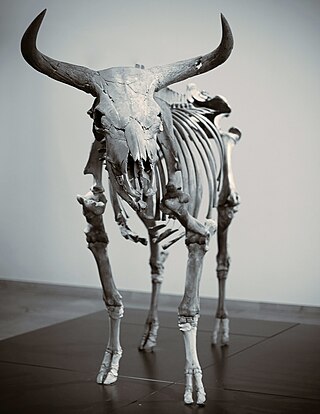
The aurochs is an extinct cattle species, considered to be the wild ancestor of modern domestic cattle. With a shoulder height of up to 180 cm (71 in) in bulls and 155 cm (61 in) in cows, it was one of the largest herbivores in the Holocene; it had massive elongated and broad horns that reached 80 cm (31 in) in length.

The Cenozoic is Earth's current geological era, representing the last 66 million years of Earth's history. It is characterised by the dominance of mammals, birds and flowering plants, a cooling and drying climate, and the current configuration of continents. It is the latest of three geological eras since complex life evolved, preceded by the Mesozoic and Paleozoic. It started with the Cretaceous–Paleogene extinction event, when many species, including the non-avian dinosaurs, became extinct in an event attributed by most experts to the impact of a large asteroid or other celestial body, the Chicxulub impactor.

Equidae is the taxonomic family of horses and related animals, including the extant horses, asses, and zebras, and many other species known only from fossils. All extant species are in the genus Equus, which originated in North America. Equidae belongs to the order Perissodactyla, which includes the extant tapirs and rhinoceros, and several extinct families.

The Pleistocene is the geological epoch that lasted from about 2,580,000 to 11,700 years ago, spanning the Earth's most recent period of repeated glaciations. Before a change was finally confirmed in 2009 by the International Union of Geological Sciences, the cutoff of the Pleistocene and the preceding Pliocene was regarded as being 1.806 million years Before Present (BP). Publications from earlier years may use either definition of the period. The end of the Pleistocene corresponds with the end of the last glacial period and also with the end of the Paleolithic age used in archaeology. The name is a combination of Ancient Greek πλεῖστος, pleīstos, 'most' and καινός, kainós, 'new'.
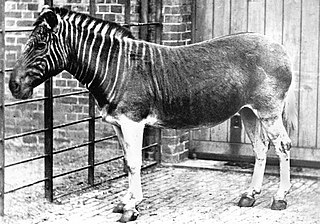
The quagga is a subspecies of the plains zebra that was endemic to South Africa until it was hunted to extinction in the late 19th century. It was long thought to be a distinct species, but early genetic studies have supported it being a subspecies of plains zebra. A more recent study suggested that it was the southernmost cline or ecotype of the species.
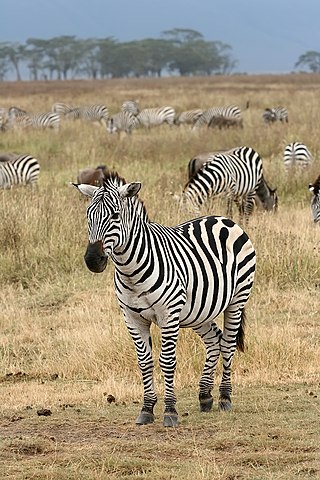
Zebras are African equines with distinctive black-and-white striped coats. There are three living species: the Grévy's zebra, plains zebra, and the mountain zebra. Zebras share the genus Equus with horses and asses, the three groups being the only living members of the family Equidae. Zebra stripes come in different patterns, unique to each individual. Several theories have been proposed for the function of these stripes, with most evidence supporting them as a deterrent for biting flies. Zebras inhabit eastern and southern Africa and can be found in a variety of habitats such as savannahs, grasslands, woodlands, shrublands, and mountainous areas.

Hippopotamidae is a family of stout, naked-skinned, and semiaquatic artiodactyl mammals, possessing three-chambered stomachs and walking on four toes on each foot. While they resemble pigs physiologically, their closest living relatives are the cetaceans. They are formally referred to as hippopotamids.
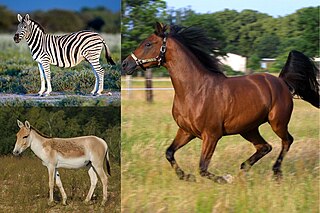
Equus, is a genus of mammals in the family Equidae, which includes horses, donkeys, and zebras. Within the Equidae, Equus is the only recognized extant genus, comprising seven living species. Like Equidae more broadly, Equus has numerous extinct species known only from fossils. The genus most likely originated in North America and spread quickly to the Old World. Equines are odd-toed ungulates with slender legs, long heads, relatively long necks, manes, and long tails. All species are herbivorous, and mostly grazers, with simpler digestive systems than ruminants but able to subsist on lower-quality vegetation.

Stegodon is an extinct genus of proboscidean, related to elephants. It was originally assigned to the family Elephantidae along with modern elephants but is now placed in the extinct family Stegodontidae. Like elephants, Stegodon had teeth with plate-like lophs that are different from those of more primitive proboscideans like gomphotheres and mastodons. The oldest fossils of the genus are found in Late Miocene strata in Asia, likely originating from the more archaic Stegolophodon, shortly afterwards migrating into Africa. While the genus became extinct in Africa during the Pliocene, Stegodon remained widespread in Asia until the end of the Pleistocene.

Pleistocene megafauna is the set of large animals that lived on Earth during the Pleistocene epoch. Pleistocene megafauna became extinct during the Quaternary extinction event resulting in substantial changes to ecosystems globally. The role of humans in causing Pleistocene megafaunal extinctions is controversial.

The Late Pleistocene is an unofficial age in the international geologic timescale in chronostratigraphy, also known as Upper Pleistocene from a stratigraphic perspective. It is intended to be the fourth division of the Pleistocene Epoch within the ongoing Quaternary Period. It is currently defined as the time between c. 129,000 and c. 11,700 years ago. The Late Pleistocene equates to the proposed Tarantian Age of the geologic time scale, preceded by the officially ratified Chibanian and succeeded by the officially ratified Greenlandian. The estimated beginning of the Tarantian is the start of the Eemian interglacial period. It is held to end with the termination of the Younger Dryas, some 11,700 years ago when the Holocene Epoch began.
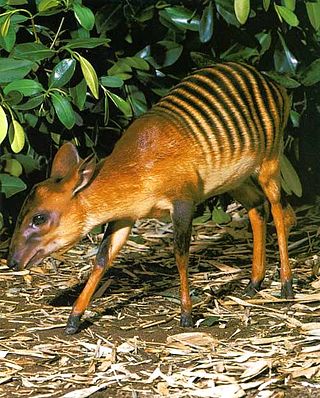
The zebra duiker is a small antelope found primarily in Liberia, as well as the Ivory Coast, Sierra Leone, and occasionally Guinea. They are sometimes referred to as the banded duiker or striped-back duiker. It is believed to be one of the earliest duiker species to have evolved.
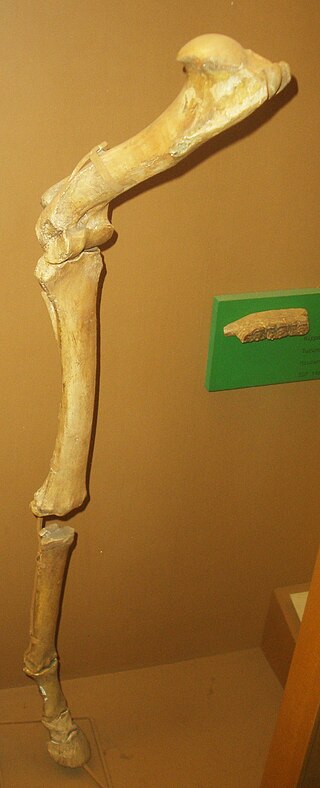
The European wild ass or hydruntine is an extinct equine from the Middle Pleistocene to Late Holocene of Western Eurasia. It appeared first in the fossil record around 350–300,000 years before present. In the late Pleistocene it was widespread throughout much of western Eurasia from the Middle East to Europe, especially along the Mediterranean, with fossil reports from Sicily, Turkey, Spain, France and Portugal. In the east the range apparently stretched at least to the Volga and to Iran. In the north it reached almost to the North Sea in Germany and the British Isles. Its range fragmented after the Last Glacial Maximum, surviving into the Holocene, its range gradually contracted further, persisting in small regions of southern Europe into the Bronze Age, and in Iran and the Caucasus into the Iron Age, around 500 BC. It has been suggested that the Iberian Zebro, extinct in the wild from the 16th century, could correspond to the Equus hydruntinus, although the word "zebro" or "cebro" comes from Latin equiferus meaning 'wild horse'. Later research judged that it was unlikely that hydruntines persisted in the Iberian Peninsula beyond the Chalcolithic.

Taurotragus is a genus of large antelopes of the African savanna, commonly known as elands. It contains two species: the common eland T. oryx and the giant eland T. derbianus.
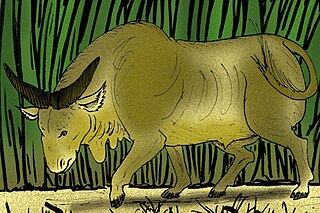
Makapania is an extinct genus of large caprine or ovibovine from the Pliocene and Pleistocene of southern and East Africa. It is remarkable in that its horns were positioned laterally. Its body weight is estimated to have been about 263 kg.

Syncerus antiquus, is an extinct species of bovid from the Pleistocene of Africa. It was one of the largest species in its family, potentially weighing up to 2,000 kilograms (4,400 lb). Due to this fact, it is sometimes known as the African giant buffalo. Syncerus antiquus became extinct at the end of the Late Pleistocene about 12,000 years ago or even during the Holocene, some 4,000 years ago.
Boomplaas Cave is located in the Cango Valley in the foothills of the Swartberg mountain range, north of Oudtshoorn, Eden District Municipality in the Western Cape Province, South Africa. It has a 5 m (16 ft) deep stratified archaeological sequence of human presence, occupation and hunter-gatherer/herder acculturation dating back 80,000 years. The site's documentation contributed to the reconstruction of palaeo-environments in the context of changes in climate within periods of the Late Pleistocene and the Holocene. The cave has served multiple functions during its occupation, such as a kraal (enclosure) for animals, a place for the storage of oil rich fruits and as a hunting camp. Circular stone hearths and calcified dung remains of domesticated sheep as well as stone adzes and pottery art were excavated indicating that humans lived at the site and kept animals.

Megalocnidae is an extinct family of sloths, native to the islands of the Greater Antilles from the Early Oligocene to the Mid-Holocene. They are known from Cuba, Hispaniola and Puerto Rico, but are absent from Jamaica. While they were formerly placed in the Megalonychidae alongside two-toed sloths and ground sloths like Megalonyx, recent mitochondrial DNA and collagen sequencing studies place them as the earliest diverging group basal to all other sloths. They displayed significant diversity in body size and lifestyle, with Megalocnus being terrestrial and probably weighing several hundred kilograms, while Neocnus was likely arboreal and similar in weight to extant tree sloths, at less than 10 kilograms.
Antidorcas bondi, or Bond's springbok, is an extinct species of antelope whose fossils have been found in Zimbabwe and South Africa.
Damaliscus hypsodon is an extinct species of antelope from the Late Pleistocene of Africa. Fossils have been found in Kenya and Tanzania.

















